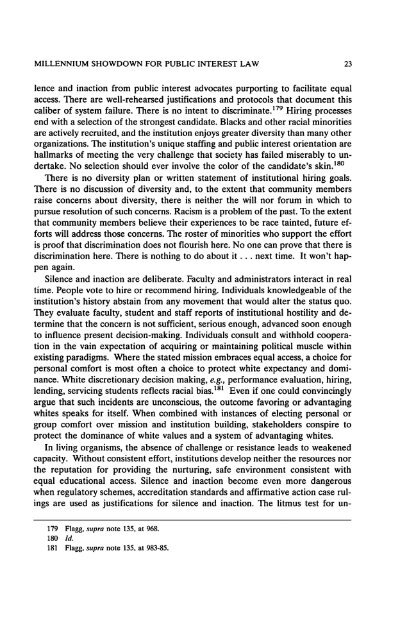Download Electronic Version - UDC Law Review
Download Electronic Version - UDC Law Review
Download Electronic Version - UDC Law Review
Create successful ePaper yourself
Turn your PDF publications into a flip-book with our unique Google optimized e-Paper software.
MILLENNIUM SHOWDOWN FOR PUBLIC INTEREST LAW 23<br />
lence and inaction from public interest advocates purporting to facilitate equal<br />
access. There are well-rehearsed justifications and protocols that document this<br />
caliber of system failure. There is no intent to discriminate. 179 Hiring processes<br />
end with a selection of the strongest candidate. Blacks and other racial minorities<br />
are actively recruited, and the institution enjoys greater diversity than many other<br />
organizations. The institution's unique staffing and public interest orientation are<br />
hallmarks of meeting the very challenge that society has failed miserably to undertake.<br />
No selection should ever involve the color of the candidate's skin.Iso<br />
There is no diversity plan or written statement of institutional hiring goals.<br />
There is no discussion of diversity and, to the extent that community members<br />
raise concerns about diversity, there is neither the will nor forum in which to<br />
pursue resolution of such concerns. Racism is a problem of the past. To the extent<br />
that community members believe their experiences to be race tainted, future efforts<br />
will address those concerns. The roster of minorities who support the effort<br />
is proof that discrimination does not flourish here. No one can prove that there is<br />
discrimination here. There is nothing to do about it ... next time. It won't happen<br />
again.<br />
Silence and inaction are deliberate. Faculty and administrators interact in real<br />
time. People vote to hire or recommend hiring. Individuals knowledgeable of the<br />
institution's history abstain from any movement that would alter the status quo.<br />
They evaluate faculty, student and staff reports of institutional hostility and determine<br />
that the concern is not sufficient, serious enough, advanced soon enough<br />
to influence present decision-making. Individuals consult and withhold cooperation<br />
in the vain expectation of acquiring or maintaining political muscle within<br />
existing paradigms. Where the stated mission embraces equal access, a choice for<br />
personal comfort is most often a choice to protect white expectancy and dominance.<br />
White discretionary decision making, e.g., performance evaluation, hiring,<br />
lending, servicing students reflects racial bias. 1St Even if one could convincingly<br />
argue that such incidents are unconscious, the outcome favoring or advantaging<br />
whites speaks for itself. When combined with instances of electing personal or<br />
group comfort over mission and institution building, stakeholders conspire to<br />
protect the dominance of white values and a system of advantaging whites.<br />
In living organisms, the absence of challenge or resistance leads to weakened<br />
capacity. Without consistent effort, institutions develop neither the resources nor<br />
the reputation for providing the nurturing, safe environment consistent with<br />
equal educational access. Silence and inaction become even more dangerous<br />
when regulatory schemes, accreditation standards and affirmative action case rulings<br />
are used as justifications for silence and inaction. The litmus test for un-<br />
179 Flagg, supra note 135, at 968.<br />
180 Id.<br />
181 Flagg, supra note 135, at 983-85.














